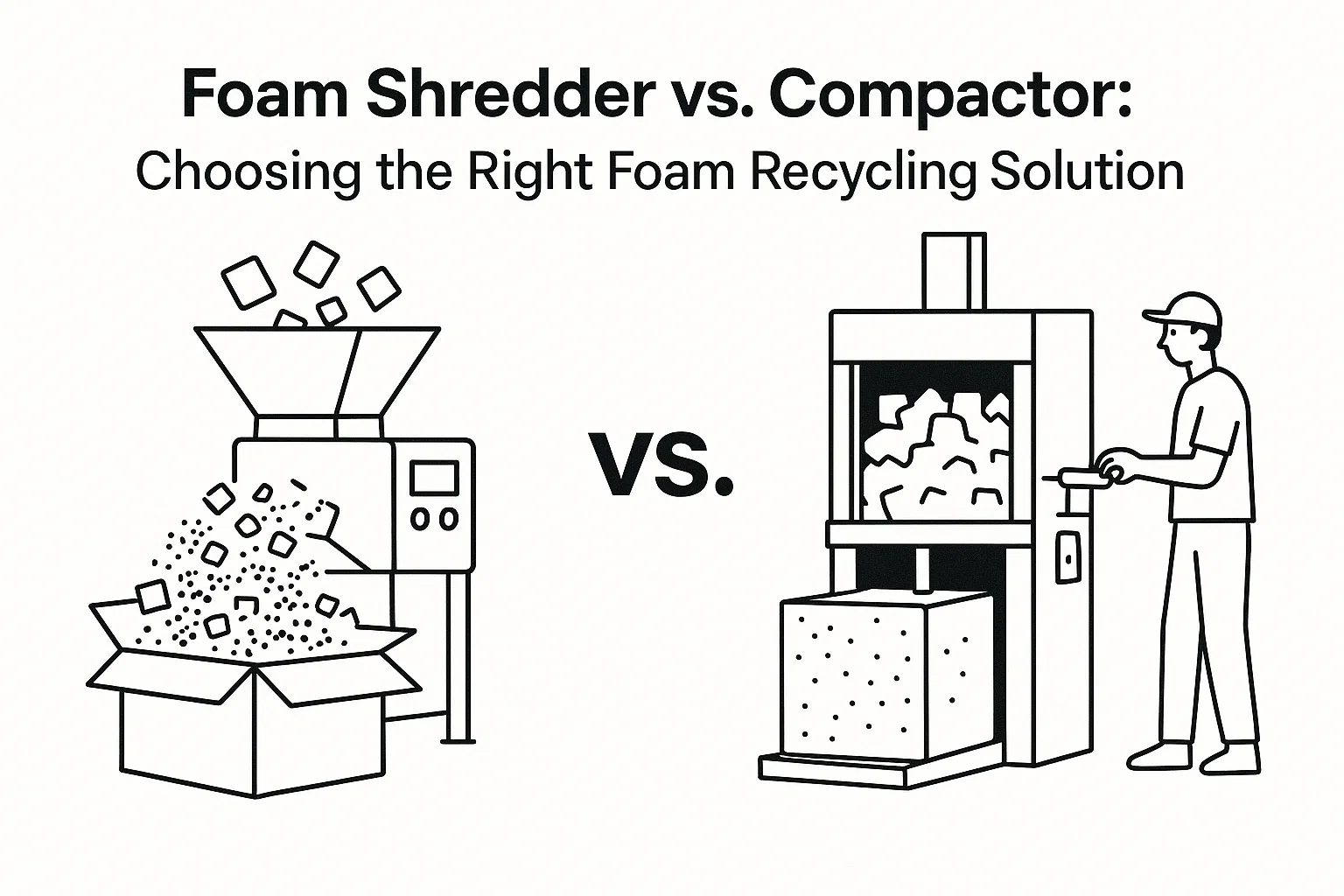Foam Shredder vs. Compactor: Choosing the Right Foam Recycling Solution
Effective foam recycling is a critical task for businesses in industries like packaging, manufacturing, and logistics. Because foam is mostly air, it is bulky and lightweight, creating significant storage and transportation challenges. Two primary types of machinery address this issue: foam shredders and foam compactors. While both play a role in waste management, they serve different functions and are suited for distinct operational goals. Understanding their differences is key to optimizing your recycling workflow and reducing costs.
A foam shredder’s main job is size reduction, breaking down large foam pieces into smaller, manageable fragments. A foam compactor, on the other hand, focuses on volume reduction, compressing foam into dense, stackable blocks. For many businesses, the choice isn’t necessarily one or the other, but rather understanding how each machine fits into a complete recycling strategy.
What is a Foam Shredder?
A foam shredder is a machine designed for the first step in many recycling processes: breaking down large, unwieldy foam waste. Using powerful rotating blades, it cuts and tears materials like expanded polystyrene (EPS), polyurethane (PU), and expanded polyethylene (EPE) into small flakes or beads. This process does not reduce the foam’s overall volume but transforms it into a consistent and manageable format for downstream processing or direct reuse.
How Foam Shredders Work and Their Primary Uses
The core mechanism of a foam shredder involves feeding bulky foam into a chamber where heavy-duty blades break it apart. The resulting shredded material is much easier to handle, convey, and feed into other equipment.
Primary applications for shredded foam include:
- Preparation for Compaction: Shredding is often a necessary preliminary step before compaction, ensuring the compactor receives a uniform feedstock for efficient processing.
- Filler Material: The shredded foam can be repurposed as a lightweight filler for products like beanbags, cushions, and toys.
- Construction Materials: In the construction industry, shredded foam is sometimes mixed with concrete to create lightweight insulating blocks.
- Packaging: The small foam fragments can serve as protective loose-fill packaging for shipping fragile items.
Advantages of a Foam Shredder
- Versatility: Can process various foam types, including rigid and soft foams like EPS, XPS, and PU.
- Creates Reusable Material: The output can be directly reused as filler or packaging material without further processing.
- Improves Workflow: Prepares foam for more efficient compaction or granulation, leading to a smoother overall recycling process.
Disadvantages of a Foam Shredder
- No Volume Reduction: Shredding only reduces piece size, not the total space the foam occupies.
- Often an Intermediate Step: For businesses focused on transport and resale, a shredder alone is usually insufficient.
- Dust Generation: The shredding process can create dust, which may require additional management.
What is a Foam Compactor?
A foam compactor, also known as a densifier, is engineered specifically to tackle the primary challenge of foam waste: its immense volume. These machines use pressure to squeeze the air out of foam, reducing its volume by as much as 50:1. The output is a dense, solid block or log that is easy to stack, store, and transport, transforming foam scrap into a valuable commodity.
Types of Foam Compactors and How They Work
Foam compactors generally fall into three categories based on their mechanism:
- Cold Compactors (Screw-Driven): These are the most common type. A large screw auger crushes the foam and pushes it through a chamber, applying intense pressure to force the air out. This mechanical process generates some heat from friction but does not actively melt the material. They are energy-efficient and ideal for materials like EPS and XPS.
- Thermal Densifiers: These machines use heat to melt the foam as it is compressed. The melted foam is then extruded and cools into a very dense, solid ingot. This method achieves the highest compression ratios, often up to 90:1, making it perfect for preparing foam for long-distance transport.
- Hydraulic Compactors: A powerful hydraulic press squeezes the foam between two plates, compacting it into a solid block. These systems are particularly effective for handling mixed densities of foam, which can be common in municipal recycling facilities.
Advantages of a Foam Compactor
- Significant Volume Reduction: Drastically cuts storage and transportation costs by ratios of up to 50:1 or even 90:1.
- Creates a Sellable Product: Compacted foam blocks are a sought-after raw material for manufacturers of new plastic products.
- Improved Logistics: Dense, stackable blocks are easy to handle and load onto pallets for shipping.
- Environmental Benefits: Diverts massive amounts of non-biodegradable foam from landfills.
Disadvantages of a Foam Compactor
- Higher Initial Investment: These machines are typically more expensive than standalone shredders.
- Energy Consumption: Thermal densifiers, in particular, require more energy to operate due to their heating elements.
- Material Specificity: Some compactors perform best with a consistent type and density of foam.
Optimize Your Foam Recycling with Energycle
Our line of high-performance EPS Recycling Machines is designed to handle your foam waste efficiently. Turn your bulky foam scrap into a manageable and valuable resource today.
View Machine DetailsDo You Need Both? The Integrated Foam Recycling System
For many large-scale operations, the most effective approach to foam recycling is not choosing between a shredder and a compactor, but integrating them into a single, streamlined system. In this setup, the foam shredder acts as the first stage, breaking down inconsistent and bulky foam waste into a uniform size. This shredded material is then fed into the compactor, which can operate more consistently and efficiently with the prepared feedstock.
This two-stage process maximizes both size and volume reduction, ensuring the highest possible density in the final output blocks. This is the optimal solution for businesses that handle high volumes of diverse foam scrap and want to produce a high-quality, marketable recycled commodity.
Decision Guide: Choosing the Right Machine for Your Business
Selecting the right equipment depends entirely on your specific needs. Consider these key factors to make an informed decision:
1. What is Your Primary Goal?
- Repurposing Foam In-House: If you plan to reuse foam as filler for your own products (e.g., furniture, packaging), a foam shredder is likely all you need.
- Reducing Disposal & Transport Costs: If your main objective is to minimize storage space and cut transportation fees, a foam compactor is the clear choice.
- Selling Recycled Material: To produce dense, high-value blocks for sale to recyclers, a foam compactor (and potentially a shredder for pre-processing) is essential.
2. What Type and Volume of Foam Do You Handle?
- Foam Type: Identify the foam you process most. Is it primarily EPS (Expanded Polystyrene), EPE (Expanded Polyethylene), or PU (Polyurethane)? While many machines are versatile, some are optimized for specific materials. For instance, hydraulic densifiers are great for mixed-density streams.
- Volume: A small business with occasional foam waste might manage with a smaller compactor. A large manufacturing plant or recycling facility will need a high-capacity system, likely integrating both a shredder and a compactor, to keep up with the waste stream.
3. What is Your Available Budget and Space?
- Investment: A standalone shredder is a lower-cost entry point into foam recycling. A compactor, especially a thermal densifier, represents a larger capital investment but offers a clearer path to ROI through cost savings and revenue generation.
- Footprint: Ensure you have adequate physical space for the machine and for storing both unprocessed and processed foam. Compactors significantly reduce the space needed for processed material.
Ultimately, both foam shredders and compactors are vital tools in the effort to manage plastic waste responsibly. By evaluating your operational goals, material types, and logistical needs, you can select the equipment that not only solves your foam waste problem but also contributes positively to your bottom line and environmental goals. To learn more about how our solutions can fit into your operations, explore the Energycle Machine homepage or consult with one of our specialists.
For further reading on the importance of plastics recycling, the U.S. Environmental Protection Agency provides valuable resources on sustainable materials management.



